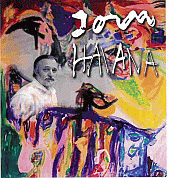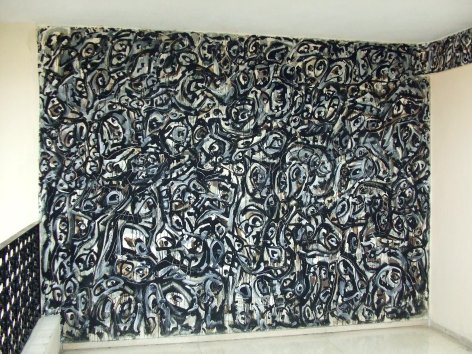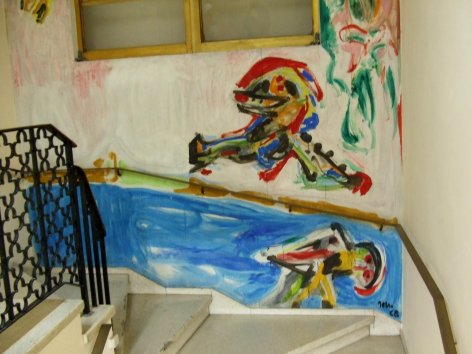Asger Jorn’s Painting Treasure in Havana
Yusimí Rodríguez, photos: Irina Echarry

HAVANA TIMES, April 20 – Few Cubans know that one can find the foremost works by a renowned twentieth-century Danish painter right here in our capital.
These are by Asger Jorn (1914-1973), one of the most outstanding neo-expressionist artists and a one-time friend of the world-recognized late Cuban painter Wifredo Lam.
They met in postwar Italy, where their friendship began; they even made ceramic pieces together. Lam invited him to Cuba in 1968.
During his stay in our country, Jorn visited the Center of Historical Affairs (currently the Office of History of the Council of State).
When seeing the bare walls of the center, he expressed his wish to reflect the genesis of the Cuban Revolution on them, but from his neo-expressionist perspective. This was how the eleven murals came to be.

I found out about this through a Cuban documentary —A. J. en La Habana, directed by Ismael Perdomo— which was shown for the first time in cinemas in our capital recently.
The documentary revolves around fifteen paintings that appeared in Copenhagen around three years ago that were attributed to Jorn, who died in that city in 1973.
It’s not known whether these paintings are actually his, though it’s supposed they were created during the official visit of the painter to our country, though there is also speculation that he came to Cuba clandestinely several times. This is what Perdomo tries to discover through his documentary.
Yet as the director himself admits, this type of investigation was no more than a pretext to produce a documentary on what occurred in the 1960s, even though he was not alive at that time nor did that period evoke nostalgia in him.

Either from being moved by the mystery about these paintings created by the director, or out of curiosity for a vision of the ‘60s that’s different from the epic image that’s been broadcast over the years here, we find ourselves captivated by the screen during the film’s 15 or 20 minutes.
The images of the Dane in Cuba, in addition to the testimony of those interviewed, allow us to see a period of contradictions and difficulties; they are anecdotes that make us smile.
In addition, there’s the image of a hard-working Asger Jorn, who would begin painting every day at eight in the morning and wouldn’t finish until after well after dark.
He also liked the music of this country and its people. In fact, at that time Jorn gave many of his paintings on poster board to workers at the Center of Historical Affairs, while he worked on the murals. Over time, and with the worsening of the of the country’s economic situation, most of those individuals were forced to sell those paintings, which are now parts of private collections.

The murals painted by Jorn stand out for their use of strident colors – yellows, blues and greens. Many people believe they recognize specific moments in the revolutionary struggle within some of these paintings, though there’s nothing figurative in these works.
“Abstract art it is not an art for understanding; rather, it’s about feeling,” said Armando Gomez, a specialist in historical documentation at the Office of History and an art history graduate himself. He also explained to me that Jorn believed the work should be understood beyond its content.
A mural on the upper floor of the facility captures one’s attention for its gray tones and the use of lines quite distinct from the other paintings.
At the same time as Jorn, another mural was painted there by Spanish painter Antonio Saura, another outstanding name in abstractionism. Though it isn’t mentioned in the documentary, Saura is perhaps the most representative figure of this form in Spain.

I don’t know if this documentary will end up having some special relevance in cinematography in our country, but at least I thank Perdomo for awakening my curiosity in this artist and in the murals he painted in Cuba.
Because of the documentary, I rushed to look for the Office of History of the Council of State, which is unknown by many here. This facility had previously been a bank and is located only yards from the corner of Linea and 12th St. Inaugurated by Celia Sanchez in 1964 with the objective of documenting the Cuban Revolution, the office contains the largest repository of archived information on the struggles of 1960s in the country.
Groups of Danes visit annually to view the murals that this painter bequeathed to Cuba in the Office of History, which —because of that collection— is described as the Sistine Chapel of abstract art.






A shame people have to sell their patrimony for bread sometimes.
When Cuba gets its fiber-optic connections to the Web thru Venezuela up and going, I certainly hope all these cuban films and documentaries we read about here are put online for free downloading to all interested parties. You couldn’t ask for a much better medium to get your word out to the World.